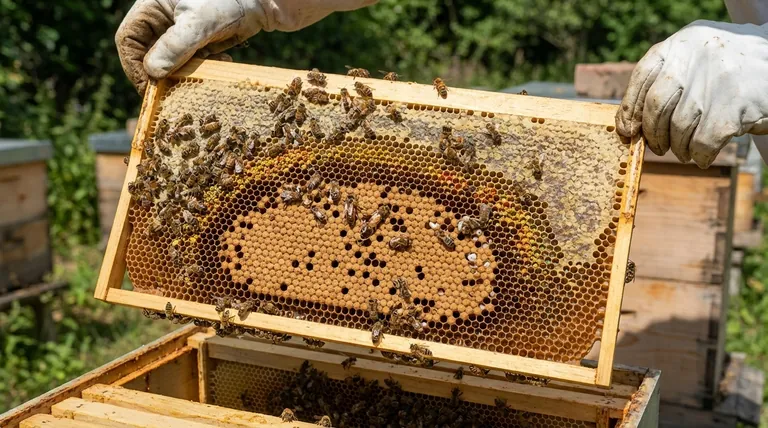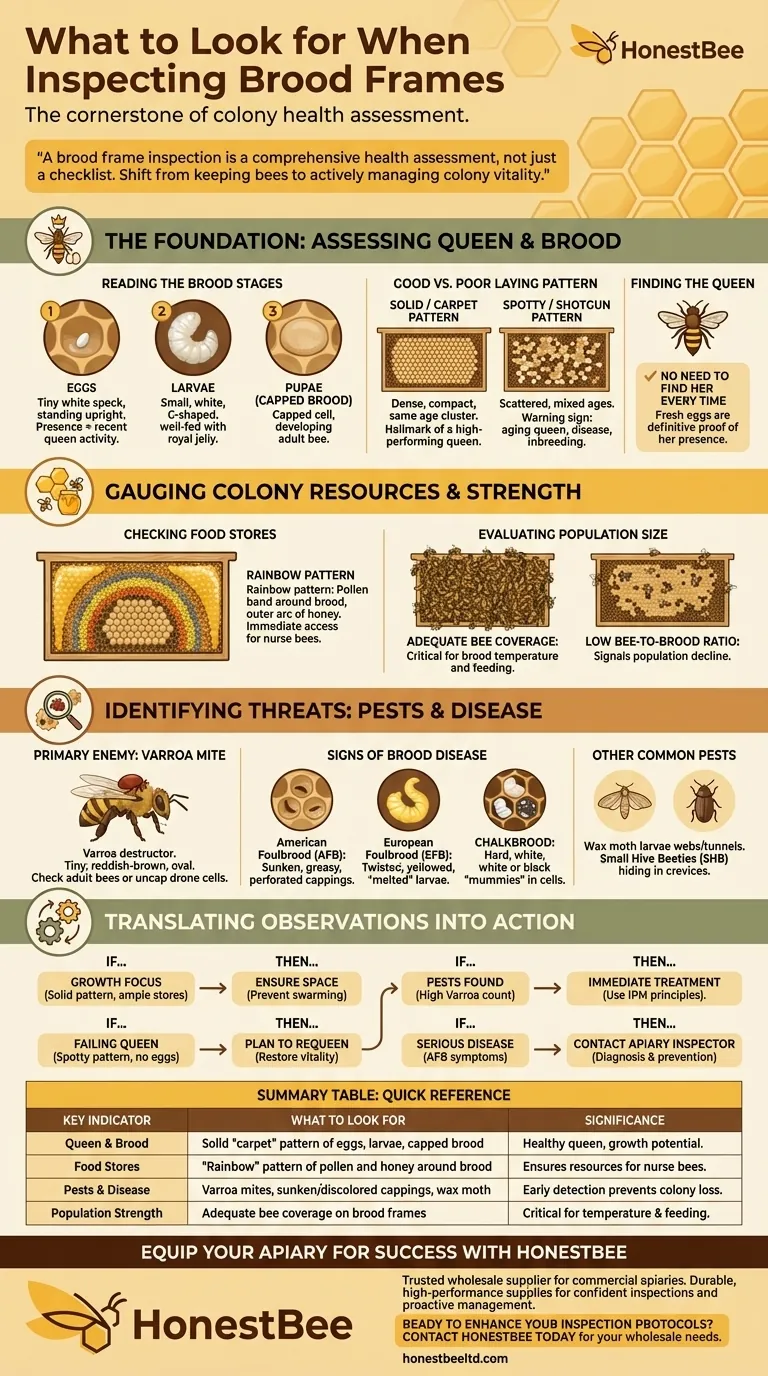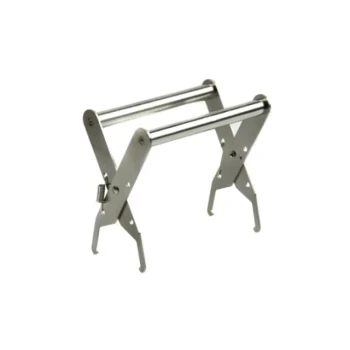Inspecting a brood frame is the single most important diagnostic you can perform on a honey bee colony. During an inspection, you are primarily looking for four key indicators: the presence and quality of the queen, the health and pattern of the brood, the availability of food stores, and any signs of pests or disease. A thorough check of these elements provides a complete picture of the colony's current health and future trajectory.
A brood frame inspection is not just a checklist; it's a comprehensive health assessment. By learning to interpret the patterns of brood, food, and bee population, you shift from simply keeping bees to actively managing colony vitality and predicting its needs.

The Foundation: Assessing the Queen and Brood
The brood nest is the heart of the colony. Its condition is a direct reflection of the queen's health and the colony's potential for growth.
Reading the Brood Stages
A healthy frame will contain brood in all stages of development, often arranged in concentric rings.
- Eggs: Look for tiny, white specks, resembling a grain of rice, standing upright in the bottom of a cell. An egg-laying queen is proof of her presence and recent activity.
- Larvae: After three days, eggs hatch into small, white, C-shaped grubs. You should see them glistening with royal jelly, indicating they are well-fed.
- Pupae (Capped Brood): Once larvae are fully grown, worker bees cap the cell with a layer of tan, slightly convex beeswax. Inside, the pupa develops into an adult bee.
What a "Good" Laying Pattern Looks Like
A prolific, healthy queen lays eggs in a dense, compact pattern. You should see a large, solid area of capped brood with cells of the same age clustered together. This is often called a "solid" or "carpet" brood pattern and is the hallmark of a high-performing queen.
Interpreting a "Poor" or "Spotty" Pattern
A scattered brood pattern, often called a "shotgun" or "pepperbox" pattern, is a significant warning sign. It indicates that many eggs or larvae are not surviving to the capped stage.
This can be caused by an aging or poorly-mated queen, inbreeding, or brood diseases that cause workers to remove sick larvae before they are capped.
Finding the Queen (and When Not To)
The queen is larger than a worker bee with a distinctively long, smooth abdomen. While it's reassuring to spot her, you do not need to find the queen in every inspection.
The presence of fresh eggs is definitive proof that a queen was present and laying within the last three days. Obsessively searching for her risks damaging the frame or accidentally injuring her.
Gauging Colony Resources and Strength
A strong brood nest is useless without the resources to support it. The edges of the brood frames reveal the colony's logistical health.
Checking Food Stores
Look for the classic "rainbow" pattern on the frame. Bees typically store a band of multi-colored pollen (bee bread) directly around the brood nest, followed by an outer arc of capped honey or glistening nectar. This ensures the nurse bees have immediate access to the protein and carbohydrates needed to feed the developing brood.
Evaluating Population Size
A healthy colony will have enough bees to completely cover the frames of brood. This "bee-to-brood" ratio is critical for maintaining the necessary temperature (around 95°F/35°C) and for feeding the thousands of hungry larvae. Frames with brood but few covering bees signal a population in decline.
Understanding the Trade-offs: Identifying Threats
A frame inspection is your primary opportunity to detect problems before they become catastrophic. Ignoring signs of pests or disease is the most common pitfall for new beekeepers.
The Varroa Mite: The Primary Enemy
Varroa destructor is the most significant threat to honey bees worldwide. Look for tiny, reddish-brown, oval-shaped mites on the bodies of adult bees or, more reliably, by uncapping a few drone cells (they prefer to reproduce in drone brood) to check for infestation.
Signs of Brood Disease
Discolored, sunken, or perforated cappings are serious red flags.
- Sunken, greasy, or perforated cappings can indicate American Foulbrood (AFB), a highly contagious bacterial disease.
- Twisted, yellowed, or "melted" larvae that are easily removed from the cell can signal European Foulbrood (EFB).
- Hard, white or black "mummies" in cells or on the bottom board indicate Chalkbrood, a fungal disease.
Other Common Pests
Be watchful for the tell-tale webs and tunnels of wax moth larvae, especially on weaker colonies or stored frames. Also, look for small, black Small Hive Beetles (SHB) that scurry away from the light and hide in crevices.
Translating Observations into Action
Your observations on the brood frame are diagnostic data that guide your next steps as a beekeeper.
- If your primary focus is growth: A solid, expanding brood pattern with ample food stores means you must ensure the colony has enough space to prevent swarming.
- If you suspect a failing queen: A spotty brood pattern, a lack of eggs, and a dwindling population means you must plan to requeen the colony to restore its genetic vitality.
- If you find evidence of pests: High Varroa mite counts or signs of other pests require immediate treatment based on integrated pest management (IPM) principles.
- If you suspect serious disease: Symptoms consistent with American Foulbrood require you to contact your local apiary inspector immediately for diagnosis and to prevent its spread.
A systematic frame inspection transforms you from a bee-keeper into a proactive colony manager.
Summary Table:
| Key Indicator | What to Look For | Significance |
|---|---|---|
| Queen & Brood | Solid 'carpet' pattern of eggs, larvae, capped brood | Indicates a healthy, productive queen and colony growth potential |
| Food Stores | 'Rainbow' pattern of pollen and honey around brood nest | Ensures nurse bees have resources to feed developing brood |
| Pests & Disease | Varroa mites, sunken/discolored cappings, wax moth larvae | Early detection allows for timely intervention to prevent colony loss |
| Population Strength | Adequate bee coverage on brood frames | Critical for maintaining brood temperature and feeding larvae |
Equip Your Apiary for Success with HONESTBEE
A thorough brood frame inspection is the cornerstone of effective colony management, but it requires the right tools and equipment. As a trusted wholesale supplier to commercial apiaries and beekeeping equipment distributors, HONESTBEE provides the durable, high-performance supplies you need to conduct inspections with confidence and efficiency.
We understand the challenges faced by large-scale operations. Our product range is designed to support your proactive health monitoring and pest management strategies, helping you maintain strong, productive colonies.
Ready to enhance your inspection protocols and streamline your beekeeping operations?
Contact HONESTBEE today to discuss your wholesale needs and discover how our equipment can contribute to the vitality and profitability of your apiary.
Visual Guide

Related Products
- Plastic Bee Frame Beekeeping Hive Frames for Wholesale
- 7 x Auto Bee Flow Hive Frames Plastic Beekeeping Hive Box Supplies
- 3.5L Plastic Beehive Frame Feeder Deep Frame Water Feeder for In Hive Use
- Professional In-Hive Bee Feeder HONESTBEE Frame for Beekeeping
- HONESTBEE Wired and Assembled Wooden Bee Frames Foundation for a Thriving Hive
People Also Ask
- Are plastic frames good? Boost Apiary Efficiency with Durable, Pest-Resistant Frames
- Why are plastic frames popular in commercial beekeeping? Boost Efficiency & Durability at Scale
- Can beekeepers switch between wooden and plastic frames? Optimize Your Hive's Performance
- What are the main types of frames available for beehives? Wood vs. Plastic for Your Apiary
- Are plastic bee hive frames good? A Guide to Modern Durability vs. Natural Appeal



















